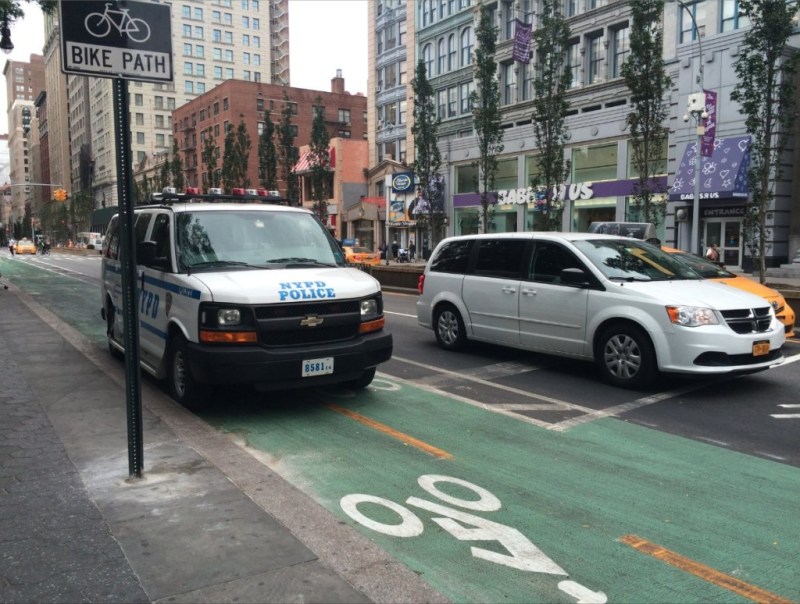NYPD and the Paranoid Narcissist’s View of Change on NYC Streets

What to make of the weekend’s New York Post cover story blaming NYC’s terrible traffic on bus lanes, bike lanes, and pedestrian plazas? Glad you asked.
If you have trouble making sense of the Post story, here’s the thesis: The city is in the grips of a powerful cabal that spans two very different mayoralties, according to unnamed sources. These forces have conspired to lay down bus lanes, bike lanes, and pedestrian plazas for a single nefarious end — to make driving so miserable that people abandon their cars.
It’s standard-issue backlash fare that ignores all the rational, public-welfare-maximizing reasons for policies that shift trips away from car travel. But instead of random loons or Koch-funded hacks telling motorists to grab their tinfoil hats, it’s anonymous police sources, including “a former top NYPD official” and “a former NYPD traffic-safety officer.” They warn the Post’s readership that “the traffic is being engineered.”
These former police officials may or may not speak for the current leadership at NYPD. But they probably represent a substantial faction within the department. So it’s worth taking a closer look at what this piece in the Post says about how certain members of our police force view our streets and how they’re changing.
The anonymous police sources have no concept of how most New Yorkers get around.
If you’re a paranoid narcissist who drives a lot, the Post’s conspiracy theory is appealing because it places you at the center of the universe. All these changes to the streets are about you and your car. You, the put-upon motorist, have every right to feel aggrieved about that new bus lane, because the city painted it just to make your life miserable. “The traffic is being engineered” to piss you off.
This is how the anonymous police sources cited by the Post view the streets of our city. To hold this perspective, they have to overlook basic facts about how most New Yorkers live.
Most New Yorkers — 54 percent of households — do not own cars. And among a substantial share of car owners, driving is not an everyday mode of travel. Only 27 percent of New York commuters get to work by driving or taking a taxi. The rest of us are taking transit, walking, biking, or telecommuting (mostly transit and walking).
The paranoid narcissist’s view of city transportation policy does not speak to all these New Yorkers who get around without driving. When street space is repurposed, New Yorkers get tangible benefits — safer walking and biking conditions, faster bus trips, and public street space that’s not overrun by traffic — and most don’t think twice about how it affects driving trips. Even frequent drivers also get around by other means (everyone has to walk sometimes), which helps explain why many car owners support street design changes like bike lanes.
The anonymous police sources are totally clueless about how New York City’s transportation system sustains a growing city.
New York City is growing at a rapid clip. In 2015, there were half a million more people and half a million more jobs in the city than in 2000. The only way to make room for this growth in travel demand is to make more efficient use of our transportation system.
New York is already blessed with an extensive high-capacity subway system, walkable street grids, and mixed-use development patterns that reduce the need for overall travel. But the city still cedes most street space to the least spatially-efficient mode of travel — driving. In order to make room for all the additional people and jobs, New York needs to repurpose its streets for walking, biking, and transit.
The police sources whining to the Post about street redesigns have failed to internalize these basic laws of urban geometry, not to mention the economics of road usage. Manhattan traffic isn’t terrible because the city added a few bus lanes, bike lanes, and plazas in the past 12 years. It has always been terrible because street space is scarce and in high demand — and yet we give it away for free to the most inefficient form of travel.
Our brave anonymous cops think that reversing a decade of progress for walking, biking, and buses will fix the city’s congestion problem. What it would really do is constrain New York’s ability to accommodate everyone who wants to live and work here — without fixing congestion in the least.
The anonymous police sources probably drive everywhere because they have parking placards.
I’m sure there are thousands of NYPD officers who don’t share the views of the anonymous sources in the Post. But neither is griping about street redesigns and the enforcement of traffic laws limited to a handful of former police officials. As an institution, NYPD has never seriously aligned with the city’s efforts to design and manage streets for people instead of cars. The progress New York has made to reduce traffic injuries, increase bicycling, and repurpose street space to speed up buses has come, by and large, despite NYPD, not because of it.
One reason — a large one — is that most police officers can park their personal vehicles for free almost anywhere they want, thanks to city-issued placards. Some cops spend their entire careers taking advantage of the free parking perk, driving everywhere. They’re divorced from the considerations that other New Yorkers must make to navigate the city and oblivious to the difficulties other New Yorkers face while getting around without a car.
The extent to which placards shape perspective is hard to overstate. Police park for free everywhere and observe the city through their windshields. They think most New Yorkers share this point of view, but they’re badly mistaken.





